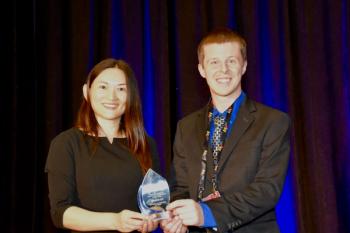Article Highlights
- The study introduces a novel approach to field-resolved molecular fingerprinting, enhancing the speed and efficiency of detecting sample constituents and internal dynamics.
- Molecular fingerprinting characterizes unique molecular features, aiding in identifying species, strains, or individuals based on molecular signatures encoded through bit string comparison.
- Lead author Hanieh Fattahi and her team demonstrate the first experimental application of compressed sensing on field-resolved molecular fingerprinting, overcoming limitations of traditional spectroscopic techniques.
- The new method enables real-time field-resolved fingerprinting with greater speed and accuracy, with practical applications ranging from environmental monitoring to pharmaceutical analysis.
A recent study introduced a novel approach to field-resolved molecular fingerprinting that can increase the speed and efficiency of detecting samples' constituents and internal dynamics, according to a recent study published in Ultrafast Science (1).
Molecular fingerprinting, also known as molecular profiling or molecular typing, refers to the process of characterizing the unique molecular features or patterns of a substance, typically molecules such as DNA, RNA, proteins, or metabolites (2). It encodes properties of small molecules and their similarities through a process known as bit string comparison (2). This technique allows scientists to identify and differentiate between different species, strains, or individuals based on their specific molecular signatures.
Lead author Hanieh Fattahi and her team from the Max Planck Institute for the Science of Light and Friedrich-Alexander University Erlangen-Nurnberg explored improving molecular fingerprinting through the use of spectroscopic techniques. In their study, they introduced a novel approach to field-resolved molecular fingerprinting that promises to revolutionize the speed and efficiency of detecting samples' constituents and internal dynamics (1).
Traditionally, two spectroscopic techniques, ultrashort time-domain spectroscopy and field-resolved spectroscopy, were used for this type of analysis (1). However, both methods had considerable limitations. Hampered by the Nyquist criterion, both these spectroscopic methods normally resulted in lengthy acquisition, processing times, and substantial data volumes (1). The Nyquist criterion explains that a signal must be sampled at a frequency that is at least twice the highest frequency component present in the signal. This frequency is known as the Nyquist rate. (3). As a result, the researchers examined in their study on how to overcome these limitations.
Read More: Identification and Analysis of Medicinal Components in Rhubarb Roots Using Terahertz Spectroscopy
To overcome the Nyquist criterion limitation, Fattahi and her team implemented and demonstrated the first experimental application of compressed sensing on field-resolved molecular fingerprinting, utilizing random scanning techniques (1). Their approach allowed for the precise identification of primary absorption peaks of atmospheric water vapor in response to terahertz light transients, all while sampling beyond the Nyquist limit (1).
By significantly undersampling the electric field of the molecular response at a Nyquist frequency of 0.8 THz, the researchers were able to successfully pinpoint water absorption peaks for up to 2.5 THz with an impressive mean squared error of 12 × 10-4 (1). As a result, the researchers were able to show that their method is a positive advancement in the field because it enabled real-time field-resolved fingerprinting with greater speed and accuracy compared to other methods (1).
Read More: Photonics West: Terahertz Spectroscopy to Detect Changes in Integrated Circuit Packaging Materials
There are also numerous practical implications in this study. Fattahi and her team also demonstrated how their method could be applied in a various number of industries. By showing the feasibility of time-domain compressed sensing, Fattahi and her team have exhibited how applications such as environmental monitoring to pharmaceutical analysis could benefit from their approach (1).
Fattahi and her team showed that their novel use of compressed sensing techniques holds the promise of transforming the way we analyze molecular fingerprints, paving the way for faster, more efficient, and more accurate spectroscopic measurements.
References
(1) Scheffter, K.; Will, J.; Riek, C.; et al. Compressed Sensing of Field-resolved Molecular Fingerprints Beyond the Nyquist Frequency. Ultrafast Science 2024, ASAP. DOI: 10.34133/ultrafastscience.0062
(2) Muegge, I.; Mukherjee, P. An Overview of Molecular Fingerprint Similarity Search in Virtual Screening. Expert Opin. Drug Discov. 2016, 11 (2), 137–148. DOI: 10.1517/17460441.2016.1117070
(3) Jones, M. Chapter 4 – Test Equipment Principles, in Building Valve Amplifiers, Second Edition, 2014, pp. 235–380. DOI: 10.1016/B978-0-08-096638-0.00004-7





